
The 1st Canadian Division is a joint operational command and control formation based at CFB Kingston, and falls under Canadian Joint Operations Command. It is a high-readiness unit, able to move on very short notice, and is staffed and equipped to meet Canada’s military objectives to counter any potential threat.

441 Tactical Fighter Squadron was a unit of the Canadian Forces. It was originally formed as a unit of the Royal Canadian Air Force (RCAF) during the Second World War. The squadron operated the McDonnell Douglas CF-18 Hornet fighter jet from CFB Cold Lake in Alberta, Canada. It was deactivated in 2006.
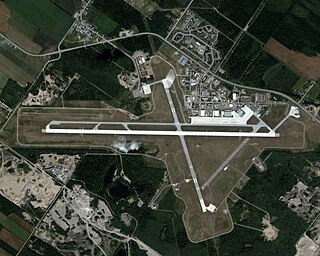
Canadian Forces Base Bagotville, commonly referred to as CFB Bagotville, and also known as Bagotville Airport or Saguenay-Bagotville Airport, is a Canadian Forces base located 4.5 nautical miles west of Bagotville in the city of Saguenay. Located in the centre of Quebec, less than 200 km (120 mi) north of Quebec City, CFB Bagotville is operated as an air force base by the Royal Canadian Air Force (RCAF) and is one of two bases in the country using the CF-18 Hornet fighter/interceptor, the other being CFB Cold Lake. Its primary RCAF lodger unit is 3 Wing, commonly referred to as 3 Wing Bagotville.

Zweibrücken Air Base was a NATO military air base in West Germany. It was located 35 miles (56 km) SSW of Kaiserslautern and 2 miles (3.2 km) SE of Zweibrücken. It was assigned to the Royal Canadian Air Force (RCAF) and the United States Air Forces in Europe (USAFE) during its operational lifetime. It was a constituent member of the Kaiserslautern Military Community.

Canadian Forces Base Baden–Soellingen or CFB Baden–Soellingen, formerly known as RCAF Station Baden–Soellingen (Baden), was a Canadian Forces base located near the farming community of Söllingen, part of the municipality of Rheinmünster in the West German state of Baden-Württemberg. It is now a commercial area called Baden Airpark, which also includes the regional airport Flughafen Karlsruhe/Baden-Baden.

1 Canadian Mechanized Brigade Group is a Canadian Forces brigade group that is part of the 3rd Canadian Division of the Canadian Army. Originally headquartered at CFB Calgary, it is currently based in CFB Edmonton in Alberta with two major units at CFB Shilo in Manitoba, and consists of eight Regular Force units.

408 Tactical Helicopter Squadron is a unit of 1 Wing, Kingston. It is co-located with 1 Canadian Mechanized Brigade Group at Canadian Forces Base (CFB) Edmonton.

CFB Edmonton is a Canadian Forces base located in Sturgeon County adjacent to the City of Edmonton in Alberta, Canada. It is also known as Edmonton Garrison or "Steele Barracks".
Canadian Forces Base Toronto is a former Canadian Forces base in Toronto, Ontario. The airfield is currently operated as Toronto / Downsview Airport.
RCAF Station Marville was a Royal Canadian Air Force (RCAF) station located near Marville in the Meuse department, Lorraine, northeastern France. It was one of four RCAF wings consisting of three fighter squadrons each, established in Europe in the early 1950s to support the goals of NATO in Europe during the Cold War. These wings were part of No. 1 Air Division. Two wings were located in France, and two were located in West Germany.
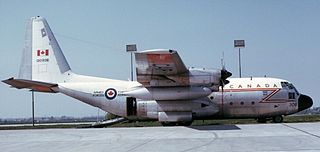
Canadian Forces Base Lahr was a military operated commercial airport located in Lahr, Germany. It was operated primarily as a French air force base, and later as a Canadian army base, beginning in the late 1960s. The military base was closed in 1994 and converted to civilian use. It is now known as the Flughafen Lahr.
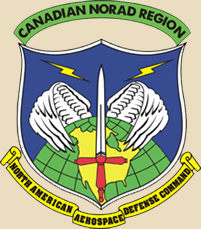
1 Canadian Air Division is the operational-level command and control formation of the Royal Canadian Air Force (RCAF). Prior to 2006 the official abbreviation for the division was 1 CAD. It is commanded by an air force major-general.
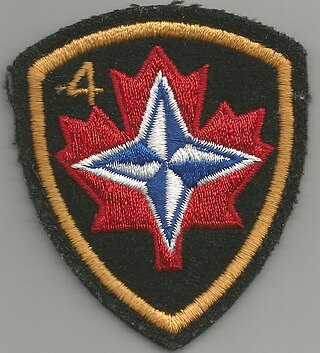
4 Canadian Mechanized Brigade Group was a formation of the Canadian Army, then Mobile Command of the unified Canadian Forces. It was part of the European formation known as Canadian Forces Europe. The formation served as the main forward deployed land element of Canada's armed forces, and was stationed in West Germany from 1957 until it was disbanded in 1993.

3rd Battalion, The Royal Canadian Regiment (3 RCR) is a regular force light infantry battalion of the Canadian Forces. 3 RCR's most notable service occurred in Korea, Germany, Bosnia and Afghanistan. In 2006–2010, the battalion was deployed to Kandahar Province, Afghanistan. All three rifle companies were deployed at various times during this period of combat. Also notable was the period between 2003 and 2004, when it was the initial Canadian Forces unit to serve as part of the International Security Assistance Force, deploying to Kabul in August 2003.

430 Tactical Helicopter Squadron is a unit of the Canadian Forces under the Royal Canadian Air Force. It operates Bell CH-146 Griffons from CFB Valcartier, near Quebec City in Quebec, Canada.
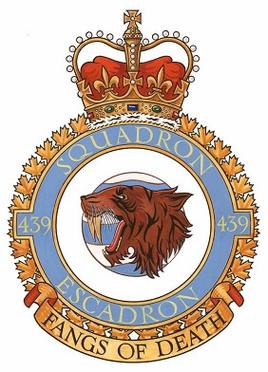
439 Combat Support Squadron is a squadron of the Royal Canadian Air Force, based in Bagotville, Quebec.
The Central Army Group (CENTAG) was a NATO military formation comprising four Army Corps from two NATO member nations comprising troops from Canada, West Germany and the United States. During the Cold War, CENTAG was NATO's forward defence in the southern half of the Federal Republic of Germany (FRG). The northern half of the FRG was defended by the four Army Corps of NATO's Northern Army Group (NORTHAG). During wartime, CENTAG would command four frontline corps. Air support was provided by Fourth Allied Tactical Air Force.

Fourth Allied Tactical Air Force was a NATO military formation under Allied Air Forces Central Europe tasked with providing air support to NATO's Central Army Group (CENTAG) in the southern portion of West Germany. 4 ATAF commanded all flying units based within its sector and all reinforcements flying into its sector, as well as ground-based radar systems and stations, air defense units and the airfields in its sector.
Enhanced Forward Presence (EFP) is a NATO-allied forward-deployed defense and deterrence military force in Central and Northern Europe. This posture in Central Europe through Poland and Northern Europe through Estonia, Latvia, and Lithuania, is in place to protect and reassure the security of NATO's Central and Northern European member states on NATO's eastern flank.
The following is a hierarchical outline for the Canadian Armed Forces at the end of the Cold War. It is intended to convey the connections and relationships between units and formations.















